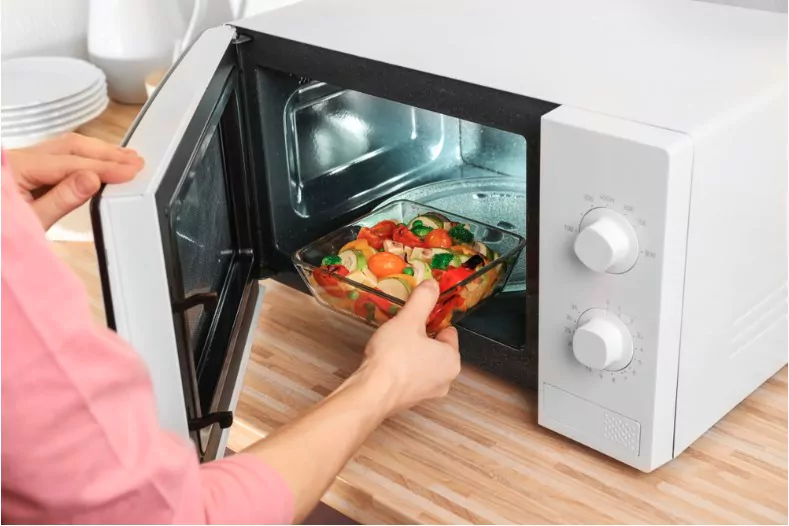Difference Between Microwave And Oven

In the modern kitchen, two different appliances, that often generate confusion are the microwave and the traditional oven. What’s the real difference between a microwave and oven? And how does it impact your cooking? Let’s embark on a culinary journey to explore these questions and more.
- Microwave Oven vs. Traditional Oven: What’s the Main Difference?
- Delving Deeper into Microwave Ovens
- Key Differences in Features and Functionality
- The Traditional Oven: An Age-old Cooking Method
- Microwave vs. Convection Oven: A Nuanced Debate
- Which is Better for Specific Cooking Needs?
- Other Considerations: Price, Space, and Versatility
- Which One is Right for You?
- Wrapping Up
1 Microwave Oven vs. Traditional Oven: What’s the Main Difference?

The difference between microwave and oven starts at the very core of their heating mechanisms. Microwaves use electromagnetic radiation, specifically microwave radiation, to directly heat the water molecules present in food. This is why food, especially those with high water content, can cook food quickly using a microwave. In contrast to microwaves, ovens use either electric coils or gas as a heating element to produce heat which cooks food indirectly, leading to a different cooking method.
2 Delving Deeper into Microwave Ovens

Microwave ovens, or simply microwaves, are generally associated with cooking food reheating. However, their capabilities go beyond just reheating food. Microwave ovens harness electromagnetic waves to penetrate food particles, exciting the water molecules within. This generates heat, which then cooks or reheats the food from the inside out.
While microwaves are generally faster than traditional ovens for many tasks, they can sometimes result in uneven heating, especially if the food item isn’t periodically turned or stirred. Microwave convection ovens, a versatile kitchen appliance, combine the quick heating of a microwave with the convection cooking capabilities of an oven. This results in evenly cooked food while retaining the microwave’ speed advantage.
3 Key Differences in Features and Functionality
Cooking Time
Microwaves cook food at a much faster rate compared to ovens due to their use of electromagnetic radiation targeting water molecules present in food. Convection ovens, however, reduce the gap in heat food cooking time with their hot air circulation.
Temperature Range
Traditional ovens can achieve higher temperatures, ideal for baking and grilling. Microwaves, on the other hand, don’t actually set a temperature but have multiple power levels to adjust the intensity of microwave radiation.
Cooking Capabilities
While you can bake bread in an oven, it’s not recommended to do so in a basic microwave. However, with the advent of microwave convection ovens, the line has blurred, allowing for a broader range of cooking and baking methods using a microwave.
Energy Efficiency

Microwaves are generally more energy-efficient than traditional ovens, especially for shorter cooking or reheating tasks. This can save money on electricity bills.
4 The Traditional Oven: An Age-old Cooking Method
The traditional oven, sometimes known as the conventional oven toaster grill, relies on either gas or electric coils to produce heat. This heat rises and cooks food by enveloping it in hot air. There are variations within traditional ovens too. The convection oven uses fans to circulate this hot air, leading to even heat distribution and faster cooking times. If you’re looking to bake bread, bake cakes, or grill meat, a convection oven or its sibling, the oven-toaster grill, is your best bet.
5 Microwave vs. Convection Oven: A Nuanced Debate
A microwave convection oven, often simply termed a convection microwave oven, combines the best of both worlds. It uses electromagnetic radiation for quick heating and a fan for even heat distribution. This versatile appliance can reheat food, bake, grill, and even roast, catering to various cooking needs.
When you use the microwave vs the convection setting, you’re employing hot air to cook food, much like a traditional oven. But when you use the microwave setting, you’re leveraging those electromagnetic waves to heat food particles directly.
6 Which is Better for Specific Cooking Needs?
For reheating most food items, microwaves edge out due to speed. But if you’re looking to bake bread, brown the top of a dish, or achieve a crispy crust, an oven or a microwave convection oven with the convection mode enabled is ideal.
Microwave vs. oven also varies in terms of energy efficiency. Microwaves, being faster, might seem like the go-to. However, convection ovens, with their even heat distribution, might cook multiple dishes at once, potentially heating time but saving more energy in the long run.
7 Other Considerations: Price, Space, and Versatility
Considering cost, a microwave oven is generally more affordable than a high-end convection oven. However difference between a microwave is, the latter can be a more versatile appliance, especially if you cook multiple dishes or bake frequently.
Space is another concern. For smaller kitchens, a bottom microwave oven is compact and perfect for reheating. But for avid cooks, investing in both two appliances might be worthwhile. For a middle ground, the convection microwave oven offers multiple cooking options without occupying much space.
8 Which One is Right for You?
Your choice between which ovens use these two appliances will depend on your cooking needs:
- Microwave: Ideal for reheating food, boiling water, and other quick tasks. It’s an energy-efficient method to reheat food, and boil water, and modern microwaves often come with multiple dishes and cooking options.
- Oven: Perfect for those who love to cook without baking or need to cook at high temperatures. The conventional oven offers a wide temperature range and ensures evenly cooked food.
- Microwave Convection Oven: This full convection microwave oven is a versatile appliance that merges the quick heating of microwaves with the even cooking capabilities of convection ovens. Suitable for households that need varied cooking methods but don’t want multiple appliances.
9 Wrapping Up
The main differences between microwave ovens and traditional ovens revolve around their heating methods, cooking capabilities, and efficiency. While microwaves use electromagnetic radiation to heat food directly, microwave ovens only rely on hot air to cook food indirectly.
Choose based on your specific cooking preferences. Whether it’s reheating, baking, grilling, or roasting, there’s a perfect kitchen appliance out there for you. Both these cooking appliances offer a plethora of options, but understanding their key differences can help you make the most of their functionalities, saving time, energy, and money in the kitchen.
Community Q&A
About This Article
This article has been viewed 305 times.



